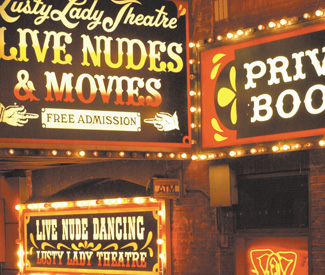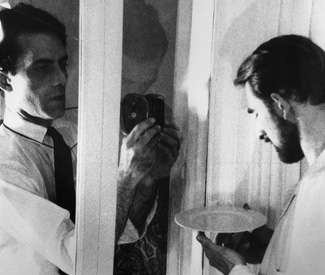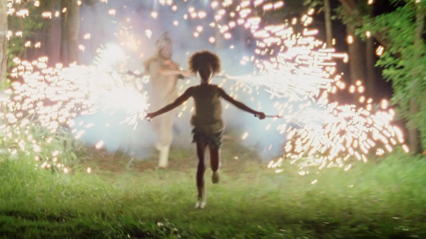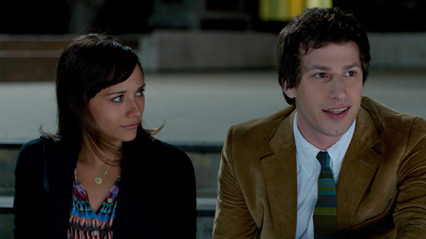Music listings are compiled by Emily Savage. Since club life is unpredictable, it’s a good idea to call ahead or check the venue’s website to confirm bookings and hours. Prices are listed when provided to us. Submit items for the listings at listings@sfbg.com. For further information on how to submit items for the listings, see Picks.
WEDNESDAY 15
ROCK/BLUES/HIP-HOP
Adam vs. Lee Huff Johnny Foley’s Dueling Piano. 9:30pm.
"Arrival From Sweden: The Music of ABBA" Yoshi’s. 8pm, $35.
Asteroids Galaxy Tour Independent. 8pm, $15.
Bitter Honeys, Tomorrow Men, Chuckleberries Elbo Room. pm, $7.
Gary Clark Jr., White Buffalo, White Dress Great American Music Hall. 8:30pm, $15.
Damir Johnny Foley’s. 9pm, free.
Daniel Ellsworth and the Grand Lakes, Kelly McFarling, Goodnight Texas Brick and Mortar Music Hall. 9pm, $5-$8.
Grimble Grumble, Soft Bombs, Space Waves Hemlock Tavern. 9pm, $6.
Ziek McCarter and the Soul Train Revival Band Boom Boom Room. 8pm, $5.
Voxel, Naked Fiction, Hungry Hungry Ghost Bottom of the Hill. 9pm, $8.
Todd Wolfe Biscuits and Blues. 8 and 10pm, $15.
JAZZ/NEW MUSIC
Cat’s Corner with Nathan Dias Savanna Jazz, 2937 Mission, SF; www.savannajazz.com. 9pm, $10.
Cosmo AlleyCats Le Colonial, 20 Cosmo Place, SF; www.lecolonialsf.com; 7-10pm.
Dink Dink Dink, Gaucho, Michael Abraham Amnesia. 7pm, free.
Greg Gotelli Quartet Medjool, 2522 Mission, SF; www.medjoolsf.com. 6-9pm, free.
Ricardo Scales Top of the Mark, 999 California, SF; www.topofthemark.com. 6:30pm, $5.
FOLK/WORLD/COUNTRY
"Hump Day Bluegrass" featuring Trespassers, Windy Hill, and more Cafe Du Nord. 8pm, $13-$15. San Francisco Bluegrass & Old-Time Festival.
DANCE CLUBS
Booty Call Q-Bar, 456 Castro, SF; www.bootycallwednesdays.com. 9pm. Juanita MORE! and Joshua J host this dance party.
Coo-Yah! Som., 2925 16th St, SF; (415) 558-8521. 10pm, free. DJs Daneekah and Green B spin reggae and dancehall with weekly guests.
Mary Go Round Lookout, 3600 16th St, SF; www.lookoutsf.com. 10pm, $5. Drag with Suppositori Spelling, Mercedez Munro, and Ginger Snap.
Megatallica Fiddler’s Green, 1333 Columbus, SF; www.megatallica.com. 7pm, free. Heavy metal hangout.
Vespa Beat Bliss Bar, 4026 24th St., SF; www.blissbarsf.com. 9pm, free. MSK.fm spins raregrooves, electroswing, and boogie.
"V" Obey the Kitty with Digitalism DJ set, Justin Milla Vessel, 85 Campton, SF; www.vesselsf.com. 10pm.
THURSDAY 16
ROCK/BLUES/HIP-HOP
Butcher Babies, Death Valley High, Eightfourseven, King Loses Crown Bottom of the Hill. 9pm, $10.
Grady Champion Biscuits and Blues. 8 and 10pm, $20.
Chelsea TK, Stereo Glitter with Chuck Gonzalez, Harbours, Michael Warren Grant, Estero Blanco Amnesia. 9pm, $7.
Class Actress, Painted Palms, Epicsauce DJs Cal Academy of Sciences, 55 Music Concourse, SF. 6pm-10pm, $12. Noise Pop pre-party.
Clusterfunk Boom Boom Room. 8pm, $5.
Fredrik, Cassowary, Mike Dineen Hemlock Tavern. 6pm, $5.
Lee Huff vs. Adam Johnny Foley’s Dueling Piano. 9:30pm.
Kamp Camille, Fox & Woman, Buxter Hootn Hemlock Tavern. 9:30pm, $6.
Ms. Lauryn Hill Warfield. 8pm, $49.50-$90.
Pocket Full of Rye, Garrin Benfield, Local Hero, Before the Brave, Little Wolves, Headcavern DNA Lounge. 5:30pm, $10-$15.
Stan Erhart Band Johnny Foley’s. 9pm, free.
Filthy Thieving Bastards, Mighty Regis, Mr. Lonesome and the Bluebelles Thee Parkside. 9pm, $8.
JAZZ/NEW MUSIC
Blues organ party Royal Cuckoo, 3202 Mission, SF; www.royalcuckoo.com. 7:30pm, free.
Stompy Jones Top of the Mark, 999 California, SF; www.topofthemark.com. 7:30pm, $10.
Leo Kottke Yoshi’s. 8pm, $30.
Tom Lander & Friends Medjool, 2522 Mission, SF; www.medjoolsf.com. 6-9pm, free.
Della Reese Rrazz Room, 222 Mason, SF; www.therrazzroom.com. 8pm, $65.
Savanna Jazz Jam with Nora Maki Savanna Jazz, 2937 Mission, SF; www.savannajazz.com. 7:30pm, $5.
FOLK/WORLD/COUNTRY
"Blue Ribbon Showcase" with Supermule, James Nash, Nomads Brick and Mortar Music Hall. 9pm, $7-$10. San Francisco Bluegrass & Old-Time Festival.
"Honky Tonk Showdown" featuring Misisipi Mike & the Midnight Gamblers, Mad Cow String Band, and more Cafe Du Nord. 8pm, $13-$15. San Francisco Bluegrass & Old-Time Festival.
JimBo Trout and the Fishpeople Atlas Cafe, 3049 Alabama, SF; www.atlascafe.net. 8-10pm, free.
Twang! Honky Tonk Fiddler’s Green, 1330 Columbus, SF; www.twanghonkytonk.com. 5pm. Live country music, dancing, and giveaways.
DANCE CLUBS
Afrolicious Elbo Room. 9:30pm, $5. With DJ/host Pleasuremaker spinning Afrobeat, Tropicália, electro, samba, and funk, and special live guest Candelaria.
Arcade Lookout. 9pm, free. Indie dance party.
Get Low Som., 2925 16th St, SF; (415) 558-8521. 10pm, free. Jerry Nice and Ant-1 spin Hip-Hop, 80’s and Soul with weekly guests.
RAW: San Francisco presents ACTIVATE 1015 Folsom, SF; www.1015.com. 8pm, $10. Music, art, and fashion. Hosted by Joe Mousepad, music by DJ Matt Haze.
Thursdays at the Cat Club Cat Club. 9pm, $6 (free before 9:30pm). Two dance floors bumpin’ with the best of 80s mainstream and underground with DJ’s Damon, Steve Washington, Dangerous Dan, and guests.
Tropicana Madrone Art Bar. 9pm, free. Salsa, cumbia, reggaeton, and more with DJs Don Bustamante, Apocolypto, Sr. Saen, Santero, and Mr. E.
"V" Base featuring Moby Vessel, 85 Campton, SF; www.vesselsf.com. 10pm.
FRIDAY 17
ROCK/BLUES/HIP-HOP
Alma Desnuda Boom Boom Room. 8pm, $15.
Apogee Sound Club, Dark Materials Queen’s Nails, 3189 Mission, SF; www.queensnailsprojects.com. 8pm, free.
"Cosmic Love Ball" featuring Eoto & Materialized, more Fillmore. 9pm, $29.50.
Bart Davenport, Sam Flax & Higher Color, Extra Classic, DJ Neil Martinson Cafe Du Nord. 9pm, $10.
Grady Champion Biscuits and Blues. 8 and 10pm, $20.
El Elle, LleGGs, Midnight Door Bottom of the Hill. 10pm, $10.
40Love, J-Billion, DJs Whooligan, Mikos Elbo Room. 10pm, $7-$10.
JGB with Melvin Seals Great American Music Hall. 9pm, $25.
Judgement Day, Whiskerman, Matthew Joseph Payne Rickshaw Stop. 8pm, $10.
Robert Earl Keen, Tiny Television Slim’s. 9pm, $25.
Eliot Lipp, Mux Mool, Random Rab 1015 Folsom, SF; www.1015folsom.com. 8pm, $20.
Jason Marion, Adam, Lee Huff Johnny Foley’s Dueling Piano. 9pm.
Saint Motel, Hundred Days, Hotel Eden Brick and Mortar Music Hall. 9pm, $7-$10.
Sole Johnny Foley’s. 9pm, free.
Symphony X, Ice Earth, Warbringer Regency Ballroom. 8pm, $32.
Terry Malts, Airfix Kits, Cocktails Hemlock Tavern. 9:30pm, $6.
Trainwreck Riders, Blank Tapes, Human Condition Independent. 9pm, $14.
Phoebe Violet San Francisco Fisherman’s Wharf Hostel, Fort Mason, Building 240 @ Cafe Franco, SF; www.norcalhostels.org. 7pm, free.
Wicked Mercies, Tontons, Gypsy Moonlight Band Thee Parkside. 9pm, $7.
JAZZ/NEW MUSIC
Audium 1616 Bush, SF; www.audium.org. 8:30pm, $20. Theater of sound-sculptured space.
Benn Bacot Savanna Jazz, 2937 Mission, SF; www.savannajazz.com. 7:30pm, 8.
Black Market Jazz Orchestra Top of the Mark, 999 California, SF; www.topofthemark.com. 9pm, $10.
Enrico Rava Tribe Herbst Theater, 401 Van Ness, SF; www.sfjazz.org. 8pm, $25-$50.
Leo Kottke Yoshi’s. 8pm, $35.
Della Reese Rrazz Room, 222 Mason, SF; www.therrazzroom.com. 8pm, $65.
FOLK/WORLD/COUNTRY
"Bluegrass Bonanza!" with Earl Brothers, Henhouse Prowlers, and more Plough & Stars. 9pm, $10-$15. San Francisco Bluegrass & Old-Time Festival.
Nell Robinson & Jim Nunally St. Cyperian’s Episcopal Church, 2097 Turk, SF; www.noevalleymusicseries.com. 7:30pm, $16-$18. San Francisco Bluegrass & Old-Time Festival.
"San Francisco Tamburitza Festival" Croation American Cultural Center, 60 Onodaga, SF; www.croatianamericanweb.org. 7:30pm, $10-$15. With Tamburaski Orkestar Momci, and Jerry Grcevich Tamburitza Orchestra.
DANCE CLUBS
Dancing Ghosts: A Gothic Lovesong Cat Club, 1190 Folsom, SF; www.dancingghosts.com. 9:30pm.
Hella Tight Amnesia. 10pm, $5.
LDL\’s Sixth Anniversary Public Works. 9pm, $15-$20. With Ewan Pearson, Todd Edwards, Danny Daze, and more.
Old School JAMZ El Rio. 9pm. Fruit Stand DJs spinning old school funk, hip-hop, and R&B.
Paris to Dakar Little Baobab, 3388 19th St, SF; (415) 643-3558. 10pm, $5. Afro and world music with rotating DJs including Stepwise, Steve, Claude, Santero, and Elembe.
Pledge: Fraternal Lookout. 9pm, $3-$13. Benefiting LGBT and nonprofit organizations. Bottomless kegger cups and paddling booth with DJ Christopher B and DJ Brian Maier.
Trannyshack: Michael vs. Janet Jackson Tribute DNA Lounge. 9:30pm, $15.
SATURDAY 18
ROCK/BLUES/HIP-HOP
Bhi Bhiman, Vandella, Misisipi Mike & Cree Rider Bottom of the Hill. 9pm, $12.
Bite, Castles in Spain, Stella Royale, Lord Rifa, Pops, Ol’ Cheeky Bastards & Cherry Doll Thee Parkside. 3pm, free.
Curtis Bumpy: Afrofunk Experience Brick and Mortar Music Hall. 9pm, $8-$11.
C$ and the Players Inc. Boom Boom Room. 8pm, $12.
Fusion Johnny Foley’s. 9pm, free.
Gomez, Hey Rosetta Fillmore. 9pm, $27.50.
Good Night Robot, Golda and the Guns, Savages Bindlestiff Studios, 185 16th St., SF; www.bindlestiffstudio.org. 8pm, $10. Benefit for Bindlestiff Studios.
Howlin Rain, Soft White Sixties, Zodiac Death Valley Independent. 9pm, $14.
Lee Huff, Adam, Jason Marion Johnny Foley’s Dueling Piano. 9pm.
Garland Jeffreys, Uncle Frank and the Co-Defendents Slim’s. 9pm, $25.
Machine Head, Suicide Silence, Darkest Hour Warfield. 7pm, $28.
Johm Nemeth Biscuits and Blues. 8 and 10pm, $20.
Neutral Uke Hotel Hotel Utah. 8pm, $12.
Oil!, Radio Reelers, Barbaric Thugs, Paper Bags Thee Parkside. 9pm, $7. Ramones tribute show.
Oliver, Viceroy, American Royalty, Fortune Cookie Rickshaw Stop. 10pm, $13-$16.
Pomplamoose, A B & the Sea Great American Music Hall. 9pm, $21.
Thee Swank Bastards, Grave Brothers Deluxe Make-Out Room. 7pm.
Victory and Associates, Police Teeth, Repeat After Me Hemlock Tavern. 9:30pm, $6.
JAZZ/NEW MUSIC
Audium 1616 Bush, SF; www.audium.org. 8:30pm, $20. Theater of sound-sculptured space.
Kenny Lattimore Yoshi’s. 8 and 10pm, $34.
Cece Peniston & Her Life Band Rrazz Room, 222 Mason, SF; www.therrazzroom.com. 9:30pm, $35.
Della Reese Rrazz Room, 222 Mason, SF; www.therrazzroom.com. 7:30pm, $65.
Suzanna Smith Savanna Jazz, 2937 Mission, SF; www.savannajazz.com. 7:30pm, $8.
FOLK/WORLD/COUNTRY
"Alt Bluegrass Show" featuring Pine Box Boys, Jugtown Pirates, Hang Jones Cafe Du Nord.9pm, $13-$15. San Francisco Bluegrass & Old-Time Festival.
"Brazilian Concert for Dogs" Wag Hotels, 25 14th St., SF; josehgarcia.eventbrite.com. 7-9pm, $20. With singer Joseh Garcia.
Saturday Night Salsa Ramp, 855 Francois, SF; www.facebook.com/therampsf. 5:30pm, $10.
DANCE CLUBS
Bootie SF: King of Pants DNA Lounge. 9pm, $10-$15. With DJ Freddy, King of Pants, and resident DJs Adrian and Mysterious D.
Fringe Madrone Art Bar. 9pm, $5. Indie music video dance party with DJ Blondie K and subOctave.
O.K. Hole Amnesia. 9pm, $5-$7.
Paris to Dakar Little Baobab, 3388 19th St, SF; (415) 643-3558. 10pm, $5. Afro and world music with rotating DJs including Stepwise, Steve, Claude, Santero, and Elembe.
Radio Franco Bissap, 3372 19th St, SF; (415) 826 9287. 6 pm. Rock, Chanson Francaise, Blues. Senegalese food and live music.
Saturday Night Soul Party Elbo Room. 10pm, $5-$10. With DJs Lucky, Paul Paul, and Phengren Oswald.
Smiths Night SF Rock-It Room. 9pm, free. Revel in 80s music from the Smiths, Joy Division, New Order, and more.
Wild Nights Kok BarSF, 1225 Folsom, SF; www.kokbarsf.com. 9pm, $3. With DJ Frank Wild.
SUNDAY 19
ROCK/BLUES/HIP-HOP
"Benefit for Visual Aid: Confession feat. Hercules & Love Affair DJ set Vessel, 85 Campton, SF; www.vesselsf.com. 6-11pm, $35.
Buck 65, Busdriver, Kristoff Krane Slim’s. 9pm, $16.
Xandra Copra, Upsets Amnesia. 5-8:30pm, $7-$10.
Heart of Orion, Haunted Echo, Eggplant Casino Brick and Mortar Music Hall. 9pm, $5-$8.
Hounds & Harlots, Radio Revolt, Time Traveling Assasins Knockout. 4pm, $5. Monika’s 31st Birthday.
Retox, Doomsday Student, Secret Fun Club, Hides Thee Parkside. 8pm, $10.
Sioux City Kid, Disposition Amnesia. 9pm, $7-$10.
Donovan Quinn, Colossal Yes, Head Cavern Hemlock Tavern. 9pm, $6.
JAZZ/NEW MUSIC
"Celebrating Eddie Marshall: Memorial Benefit Concert" Yoshi’s. 1pm, $40. With Bobby McFerrin, Bobby Hutcherson, and more.
Kenny Lattimore Yoshi’s. 6 and 8pm, $30.
Cece Peniston & Her Life Band Rrazz Room, 222 Mason, SF; www.therrazzroom.com. 7pm, $35.
Savanna Jazz Jam with Kelly Park Savanna Jazz, 2937 Mission, SF; www.savannajazz.com. 7pm, $5.
Sophisticated Ladies Quartet Bliss Bar, 4026 24th St., SF; www.blissbarsf.com. 4:30-7:30pm, $10.
FOLK/WORLD/COUNTRY
"Festival Closing Night" featuring Crooked Jades, Deadly Gentleman Cafe Du Nord. 8:30pm, $15. San Francisco Bluegrass & Old-Time Festival.
"San Francisco Tamburitza Festival" Croation American Cultural Center, 60 Onodaga, SF; www.croatianamericanweb.org. 12-8pm, $10-$15. With Tamburaski Orkestar Momci, and Jerry Grcevich Tamburitza Orchestra.
Sunday Night Salsa Ramp, 855 Francois, SF; www.facebook.com/therampsf. 5:30pm, $10.
Twang Sundays Thee Parkside. 4pm, free. With Merle Jagger.
DANCE CLUBS
Batcave Club 93, 93 9th St, SF 10pm, $5. Death rock, goth, and post-punk with Steeplerot, XChrisT, Necromos and c_death.
Cheryl + Girl Walk // All Day Public Works. 9pm, $5-$10. Girl Talk’s feature length music video, DJ Nick, Dance Party by Cheryl.
Dub Mission Elbo Room. 9pm, $11-$15. Dub, roots, and classic dancehall with Zion Train, featuring Neil Perch and DJ Rocker T.
Jock Lookout, 3600 16th St, SF; www.lookoutsf.com. 3pm, $2. Raise money for LGBT sports teams while enjoying DJs and drink specials.
La Pachanga Blue Macaw, 2565 Mission, SF; www.thebluemacawsf.com. 6pm, $10. Salsa dance party with live Afro-Cuban salsa bands.
MONDAY 20
ROCK/BLUES/HIP-HOP
Hot Chelle Rae, Cady Groves, Electric Touch Slim’s. 7:30pm, $16-$18.
Persephone’s Bees, Christina Courtin Cafe Du Nord. 9:30pm, $10.
Polica, Jhameel, Hudson Bell Bottom of the Hill. 9pm, $10.
JAZZ/NEW MUSIC
Bossa Nova Tunnel Top, 601 Bush, SF; (415) 722-6620. 8-11:30pm, free. Live acoustic Bossa Nova.
Keith Sweat Yoshi’s. 8 and 10pm, $45.
FOLK/WORLD/COUNTRY
Chucho Valdes & the Afro-Cuban Messengers Herbst Theater, 401 Van Ness, SF; www.sfjazz.org. 7:30pm.
DANCE CLUBS
Death Guild DNA Lounge. 9:30pm, $3-5. Gothic, industrial, and synthpop with Joe Radio, Decay, and Melting Girl. With Industrial Girl Bike Gang.
M.O.M. Madrone Art Bar. 6pm, free. DJs Timoteo Gigante, Gordo Cabeza, and Chris Phlek playing all Motown every Monday.
Sausage Party Rosamunde Sausage Grill, 2832 Mission, SF; (415) 970-9015. 6:30-9:30pm, free. DJ Dandy Dixon spins vintage rock, R&B, global beats, funk, and disco at this happy hour sausage-shack gig.
Sucker Punch Elbo Room. 10pm, $5. With resident DJ Rapid Fire, hosted by Nate Always.
TUESDAY 21
ROCK/BLUES/HIP-HOP
Burmese, Sutekh Hexen, Folivore Hemlock Tavern. 9pm, $5.
Cursive Amoeba, 1427 Haight, SF; www.amoeba.com. 7pm, free.
Darkness, Foxy Shazam, Crown Jewel Defense Fillmore. 8pm, $26.50.
Darsombra, Grayceon, Winter Teeth Knockout. 9:30pm.
Craig Finn, Mountain Moriah, Sad Baby Wolf, Ash Reiter Bottom of the Hill. 8pm, $15.
Jaws, Sewn Leather, Dracula Lewis, Creature Comforts Amnesia. 10pm. $6.
"Mardi Gras with the Fat Tuesday Band" Biscuits and Blues. 8 and 10pm, $15.
Andy McKee, Stephen Bennet & Antoine Dufour Great American Music Hall. 8pm, $23.
Okay, Drift, Martha Grover from Somnabulist Cafe Du Nord. 8pm, $10-$12.
Wooster Boom Boom Room. pm, $5.
JAZZ/NEW MUSIC
Chieftains Davies Symphony Hall, 201 Van Ness, SF; www.sfjazz.org. 7:30pm. SF Jazz.
Keith Sweat Yoshi’s. 8 and 10pm, $45.
Zapp Band & Shirley Murdock Rrazz Room, 222 Mason, SF; www.therrazzroom.com. 8pm, $35.
DANCE CLUBS
Carnaval! Elbo Room. 9pm, $7-$10. Live performances by Fogo Na Roupa, Mondo Loko, residents Carioca and P-Shot.
Eclectic Company Skylark, 9pm, free. DJs Tones and Jaybee spin old school hip hop, bass, dub, glitch, and electro.
Post-Dubstep Tuesdays Som., 2925 16th St, SF; (415) 558-8521.10pm, free. DJs Dnae Beats, Epcot, Footwerks spin UK Funky, Bass Music.








